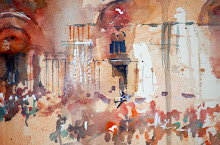Saunders Waterford paper 200lbs
Rough
I have received so many quesions about the watercolour paper that I use and felt the easiest way to answer them would be by blog posts. Many new artists find choosing watercolour paper realy confusing as there are so many varieties available. Firstly and most importnatly I have to make it clear , using cheap paper that isn't suited to watercolour as a medium is not worth your time, effort or money. These can lead to soul destroying experiences and even make you feel as though you can't paint. When all along it isn't you thats' at fault, its' your paper.
Cheap thin paper buckles when water is applied. It often doesn't give you the fabulous watercolour effects that occur when pigment dries because colour can spuddle on cheap paper surfaces. Rather than interact forming the gorgeous patterns that make painting in watercolour really addictive. I love watching colour flow over the surface of watercolour paper. I also adore the effects that occur during drying stages. I should point out at this stage that I always let my work dry naturally. I never use a hair dryer to speed up the creative process as I believe this destroys the natural magic of watercolour pigment interaction.
So lets' start with looking at watercolour papers available. Today, I am going to look at St Cuthbert Mills range because they are experts at creating top quality products for artists. They produce several fabulous papers but I have been looking at the Saunders Waterford 200lb series, Rough Surface whilst working on a series of animals.
What I loved most about this paper is that my colour washes flow easily over the whole surface. No matter ho wlarge the paper is. My brush glides readily from corner to corner and when I have finished applying colour no puddles are visible. The various pigments can interact freely , during the drying period the emerging effects are stunning.
Looking at two close ups of my new "cat" painting I can observe how beautifully my results are. Clean, fresh colour is lietrally singing on paper when allowed to merge with water to create the watercolour effects that I love so much.
Close up of a cats eye in the early stages of my new wtaercolour collection. Notice the gorgeous watermark between the Opera Rose, Translucent Orange and pure water. This watermark will form the fur marking of the cat I am currently painting.
Another interesting quality of this particular paper is that it allows me to lift colour gently as I have in the above eye, to remove a soft area of colour to add light. Cheap papers do not allow you to do this. They can tear, or the paper surface can be ruined in a way that is obvious when your work is later framed. Imagine spending hours on a beautiful painting which you then have to throw away at a later stage because the paper has buckled, or the surface has been damaged during the painting process. It can really take the enjoyment out of painting, so using good quality products is vital.
Another close up of the same painting. Notice how the Translucent Orange is sitting happily on the dry paper but merging softly with the turquoise layer underneath it.
The fact is, if you want to enjoy painting , no matter what level of artist you are. You really do need to use the correct materials. Unfortunately whilst there are many student quality papers on the maket they just don't give you the most amazing experience of working in watercolour as using gorgeous good paper can.
I would definitely recommend trying Saunders Waterford watercolour paper. If like me you use more water then try the 200lbs. Out of interest I use rough surfaces when working on animals as I gain a terrific effect for fur with them, rather than smooth paper surfaces which I use for painting florals with silky petals or labradors with shiny coats.
Whatever you do, don't waste your time on paper that will buckle, allow colour to puddle or tear easily.
Have fun experimenting with different papers, use the best you can afford and look out for bargains from art suppliers as they ofen have special offers. Try teaming up with your Art Society or artist friends and buy paper in bulk too to share. Thats' a great way to save money!
*****************














































